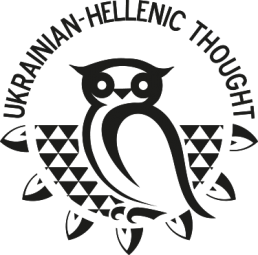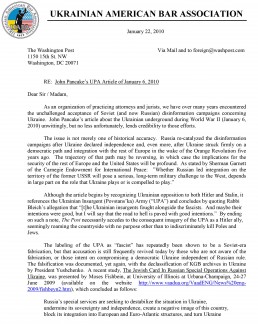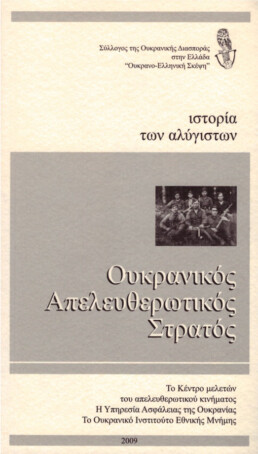Η Ουκρανία στον Β’ Παγκόσμιο πόλεμο/Україна в Другій світовій війні
Σχετικά με το επόμενο κύμα προπαγάνδας, που κάθε φορά τέτοιες μέρες για δεκαετίες ανακυκλώνει η Ρώσικη Ομοσπονδία ως διάδοχος της Σοβιετικής Ένωσης, θα θέλαμε να σας παρουσιάσουμε κάτι αντίστοιχο από το 2010 που πολύ καλά εξηγεί την αληθινή τάξη πραγμάτων.
Όποιος πραγματικά ενδιαφέρεται για το θέμα, με λίγη προσπάθεια θα μπορούσε πραγματικά να ανακαλύψει πολλές πληροφορίες θαμμένες κάτω από τεράστιων διαστάσεων προπαγανδιστικά βέλη εναντίον των ανθρώπων, που μοναδικό τους “έγκλημα” αποτελούσε ο αγώνας για την Ελευθερία της Πατρίδας τους και εναντίωσή τους στο φασιστικό χιτλερικό και σοβιετικό καθεστώς.
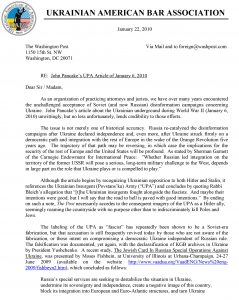
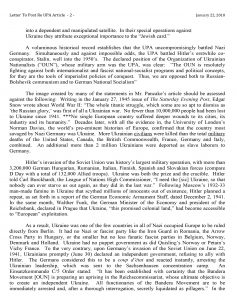
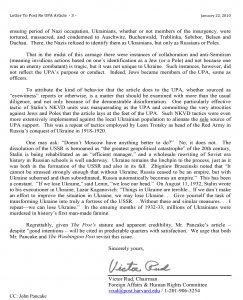
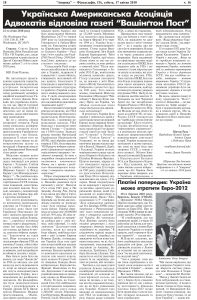
Ουκρανικός Απελευθερωτικός Στρατός: ιστορία των αλύγιστων
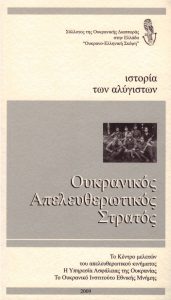 Грецький варіант брошури про УПА
“Ουκρανικός Απελευθερωτικός Στρατός: ιστορία των αλύγιστων”
Εκδότης: Κοινότητα της Ουκρανικής διασποράς στην Ελλάδα «Ουκρανο-Ελληνική Σκέψη»
Έτος: 2009
Κυκλοφορία: 1500 αντίτυπα
Επιμέλεια της ελληνικής έκδοσης: Γαλήνη Μασλιούκ
В Афінах 1 листопада відкрилася виставка “УПА.Історія нескорених”
Грецький варіант брошури про УПА
“Ουκρανικός Απελευθερωτικός Στρατός: ιστορία των αλύγιστων”
Εκδότης: Κοινότητα της Ουκρανικής διασποράς στην Ελλάδα «Ουκρανο-Ελληνική Σκέψη»
Έτος: 2009
Κυκλοφορία: 1500 αντίτυπα
Επιμέλεια της ελληνικής έκδοσης: Γαλήνη Μασλιούκ
В Афінах 1 листопада відкрилася виставка “УПА.Історія нескорених”
Δελτίο τύπου
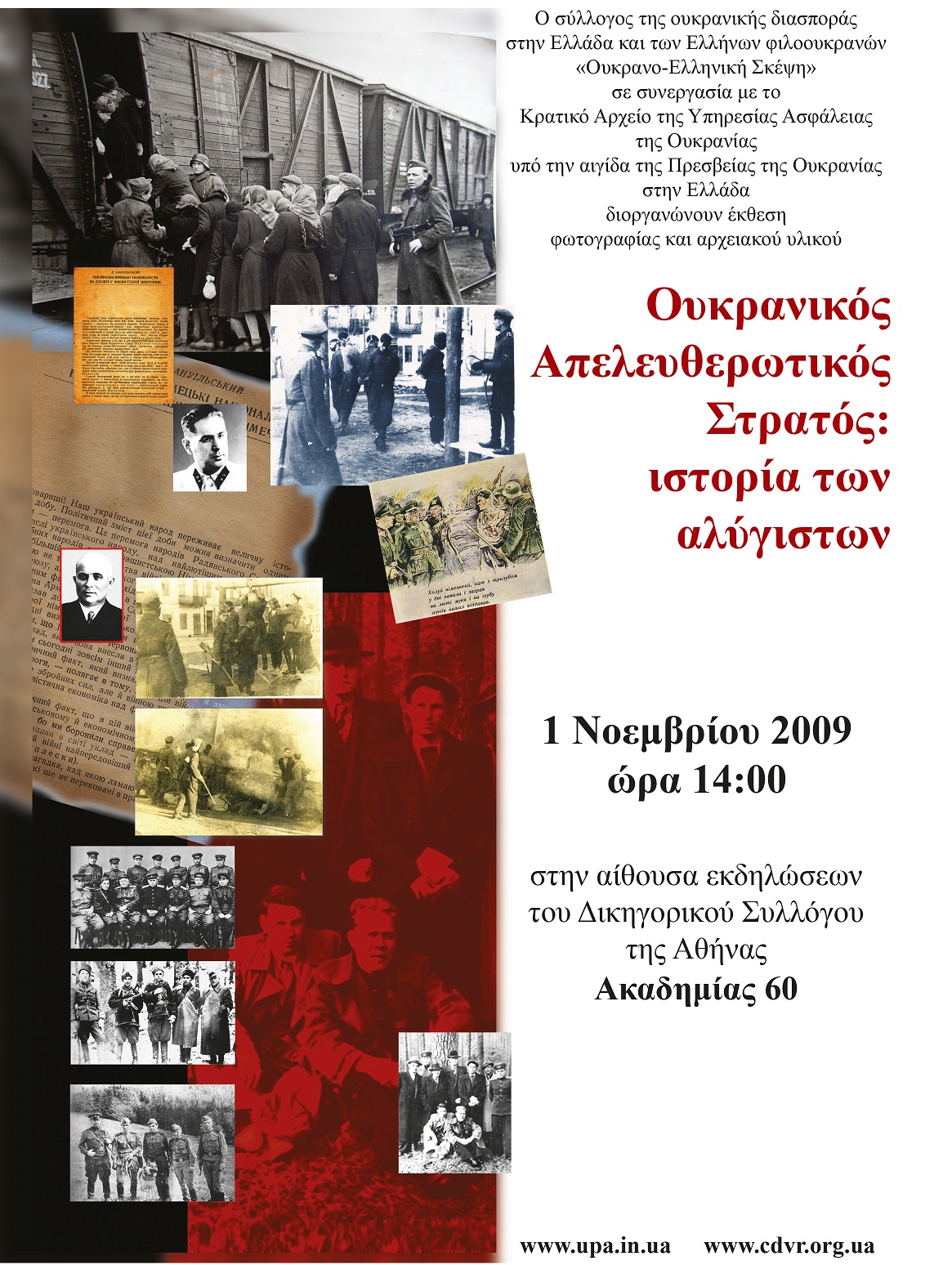 Η έκθεση αρχειακού υλικού και φωτογραφίας με τίτλο “Ουκρανικός Απελευθερωτικός Στρατός: ιστορία των αλύγιστων” είναι αφιερωμένη στους ηρωικούς αγώνες του ουκρανικού λαού για ανεξαρτησία. Η διοργάνωσή της εδώ στην Ελλάδα, έχει ως στόχο να γίνει γνωστή η ιστορία της Ουκρανίας στους Έλληνες και ν' αποκατασταθεί η αλήθεια και στον ελληνικό χώρο όσον αφορά τη δράση των Ουκρανών αγωνιστών. Τα εγκαίνια της έκθεσης και η ημερίδα πραγματοποιήθηκαν την Κυριακή 1 Νοεμβρίου 2009 ώρα 14.00 στην αίθουσα εκδηλώσεων του Δικηγορικού συλλόγου Αθήνας στη διεύθυνση: Ακαδημίας 60, Αθήνα με τη συμμετοχή του Προέδρου των Κρατικών αρχείων της Υπηρεσίας Ασφάλειας της Ουκρανίας κ. Βολοντιμίρ Βιατρόβιτς και του Γενικού Γραμματέα του Παγκόσμιου Κογκρέσου της Ουκρανικής διασποράς από την Αυστραλία κ. Στέφαν Ρομάνιβ. Την εκδήλωση διοργάνωσε ο Σύλλογος της ουκρανικής διασποράς στην Ελλάδα και των Ελλήνων φιλοουκρανών «Ουκρανο-Ελληνική Σκέψη» σε συνεργασία με τα Κρατικά αρχεία της ΥΑΟΥ υπό τη αιγίδα της Πρεσβείας της Ουκρανίας στην Ελλάδα.
Η ιστορία της Ουκρανίας είναι η ιστορία του αγώνα του λαού της για την ανεξαρτησία. Η πιο έντονη και η πιο μαζική βούληση των Ουκρανών να δημιουργήσουν το δικό τους κράτος διαφάνηκε τον ΧΧ αιώνα. Επιτέλους, στις 24 Αυγούστου 1991 κατάφεραν να επιτευχθεί η ανεξαρτησία και στο χάρτη του κόσμου εμφανίστηκε ένα νέο κράτος. Παρόλα αυτά, χρόνια μετά από αυτό το γεγονός, λίγοι γνωρίζουν για τον ιστορικό αγώνα των Ουκρανών – όχι μόνο στον κόσμο, αλλά μέσα στην ίδια την Ουκρανία. Οι επιπτώσεις των αποικιακών καιρών ακόμα βαραίνουν το παρελθόν της. Τις περισσότερες διαμάχες τόσο στην Ουκρανία όσο κι έξω από τα σύνορά της, προκαλεί η περίοδος του ένοπλου αγώνα υπό την καθοδήγηση της Οργάνωσης των Ουκρανών Εθνικιστών (ΟΟΥΕ) και του Ουκρανικού Απελευθερωτικού Στρατού (ΟΥΑΣ), καθώς επίσης η αντίσταση αυτών των οργανώσεων στο γερμανικό και στο σοβιετικό καθεστώς για πάνω από δέκα χρόνια. Αυτό το ζήτημα προσπαθούν συνεχώς να χρησιμοποιήσουν διάφορες πολιτικές δυνάμεις για τη διάσπαση του Ουκρανικού λαού, ενώ ακριβώς η ιδέα του αγώνα για την ανεξαρτησία θα έπρεπε να τον ενώσει.
Τώρα ήρθε η ώρα, η ανεξάρτητη Ουκρανία ν' αποκαλύψει στον εαυτό της και σ' όλο τον κόσμο την αληθινή της ιστορία. Επιστρέφουν από τη λήθη τα διακεκριμένα μας πρόσωπα, τα μοιραία γεγονότα, ολόκληρες ιστορικές στρώσεις. Άλλοτε έκρυβαν, απαγόρευαν ή διαστρέβλωναν χωρίς καμιά ντροπή την αλήθεια. Ίσως περισσότερο απ’ όλα το σοβιετικό καθεστώς προσπαθούσε να σβήσει τη μνήμη των ηρωικών αγώνων των Ουκρανών για ανεξαρτησία και ειδικά του Ουκρανικού Απελευθερωτικού Στρατού.
Ο αγώνας του ΟΥΑΣ αποτέλεσε μεγάλη ηθική νίκη του λαού μας, σύμβολο του αλύγιστου και ανίκητου πνεύματός του. Ενώ φαινομενικά οι Ουκρανοί αγωνιστές δεν είχαν καθόλου ελπίδες, αντιστέκονταν ταυτόχρονα σε δυο ισχυρά ολοκληρωτικά καθεστώτα – των ναζί και των κομμουνιστών. Γνώριζαν ότι η μάχη ήταν χαμένη, κι όμως αγωνίζονταν γιατί ήξεραν ότι δίχως σταύρωση δεν υπάρχει ανάσταση. Και η πορεία της ιστορίας απέδειξε ότι η θυσία για τον ιερό σκοπό δεν είναι ποτέ μάταιη. Πέρασαν χρόνια, και πάνω στα ερείπια του ολοκληρωτισμού ξεπρόβαλε η ανεξάρτητη Δημοκρατική Ουκρανία που υπάρχει και ζει χάρη στη θυσία αυτών των ανθρώπων. Τους χρωστάμε την ελευθερία της ύπαρξής μας και της σκέψης μας.
Τώρα ήρθε η ώρα να τιμήσουμε τους ήρωες όπως τους αρμόζει. Έχουμε χρέος ν' αναστήσουμε την αλήθεια για τον Ουκρανικό Απελευθερωτικό Στρατό και να τη μεταφέρουμε στις νεότερες γενιές ως παρακαταθήκη που μας καλεί να υπηρετούμε την Πατρίδα.
Αξίζει να αναφερθεί ότι στα εδάφη όπου δρούσε ο ΟΥΑΣ ο λαός έχει προ πολλού αναγνωρίσει τους αγωνιστές – σχεδόν σε κάθε χωριό της Δυτικής Ουκρανίας μπορεί κανείς να δει ένα μνημείο που ανεγέρθηκε με πρωτοβουλία της κοινότητας· εδώ ακόμα θυμούνται τα ονόματα των ηρώων που προέρχονται από αυτό το μέρος. Όχι μόνο οι ηλικιωμένοι, αλλά και οι νέοι τραγουδάνε με θέρμη τα πατριωτικά τραγούδια. Αντίθετα, σε άλλα μέρη της Ουκρανίας φέρονται επιφυλακτικά στον ΟΥΑΣ, ακόμα και με ανοιχτή έχθρα. Είναι ολοφάνερο ότι αυτή η συμπεριφορά διαμορφώθηκε όχι από την προσωπική εμπειρία επικοινωνίας με τους αγωνιστές, αλλά είναι μόνο το αποτέλεσμα της προπαγάνδας του σοβιετικού καθεστώτος.
Υπάρχει, λοιπόν, ανάγκη να μάθουν όλοι για τον ΟΥΑΣ, τις πηγές της ίδρυσής του, την ιστορία της εξέλιξής του, των ανθρώπων που τον δημιούργησαν. Να διηγηθούμε τη δράση του με την πιο κατανοητή και πειστική γλώσσα – τη γλώσσα των φωτογραφιών. Αν κοιτάξει κανείς στα μάτια εκείνων των αγοριών και των κοριτσιών που πριν πάνω από μισό αιώνα έχυσαν το αίμα τους για το μέλλον μας, θα μπορέσει ο καθένας να καταλάβει ότι ανήκουν σ' ένα παρελθόν που δεν μπορεί να πεθάνει.
Γι' αυτό, η δημοσιοποίηση των αρχείων την οποία διενεργεί η Υπηρεσία Ασφάλειας της Ουκρανίας είναι πολύ σημαντική. Σίγουρα, η έκθεση «Ουκρανικός Απελευθερωτικός Στρατός: ιστορία των αλύγιστων» θα αποκαλύψει σε πολλούς στην Ουκρανία και πέρα από τα σύνορά της μια ακόμα άγνωστη ηρωική σελίδα του παρελθόντος, θα γίνει ένα μεγάλο βήμα στο δρόμο της αναγέννησης της εθνικής μας μνήμης.
Η έκθεση αρχειακού υλικού και φωτογραφίας με τίτλο “Ουκρανικός Απελευθερωτικός Στρατός: ιστορία των αλύγιστων” είναι αφιερωμένη στους ηρωικούς αγώνες του ουκρανικού λαού για ανεξαρτησία. Η διοργάνωσή της εδώ στην Ελλάδα, έχει ως στόχο να γίνει γνωστή η ιστορία της Ουκρανίας στους Έλληνες και ν' αποκατασταθεί η αλήθεια και στον ελληνικό χώρο όσον αφορά τη δράση των Ουκρανών αγωνιστών. Τα εγκαίνια της έκθεσης και η ημερίδα πραγματοποιήθηκαν την Κυριακή 1 Νοεμβρίου 2009 ώρα 14.00 στην αίθουσα εκδηλώσεων του Δικηγορικού συλλόγου Αθήνας στη διεύθυνση: Ακαδημίας 60, Αθήνα με τη συμμετοχή του Προέδρου των Κρατικών αρχείων της Υπηρεσίας Ασφάλειας της Ουκρανίας κ. Βολοντιμίρ Βιατρόβιτς και του Γενικού Γραμματέα του Παγκόσμιου Κογκρέσου της Ουκρανικής διασποράς από την Αυστραλία κ. Στέφαν Ρομάνιβ. Την εκδήλωση διοργάνωσε ο Σύλλογος της ουκρανικής διασποράς στην Ελλάδα και των Ελλήνων φιλοουκρανών «Ουκρανο-Ελληνική Σκέψη» σε συνεργασία με τα Κρατικά αρχεία της ΥΑΟΥ υπό τη αιγίδα της Πρεσβείας της Ουκρανίας στην Ελλάδα.
Η ιστορία της Ουκρανίας είναι η ιστορία του αγώνα του λαού της για την ανεξαρτησία. Η πιο έντονη και η πιο μαζική βούληση των Ουκρανών να δημιουργήσουν το δικό τους κράτος διαφάνηκε τον ΧΧ αιώνα. Επιτέλους, στις 24 Αυγούστου 1991 κατάφεραν να επιτευχθεί η ανεξαρτησία και στο χάρτη του κόσμου εμφανίστηκε ένα νέο κράτος. Παρόλα αυτά, χρόνια μετά από αυτό το γεγονός, λίγοι γνωρίζουν για τον ιστορικό αγώνα των Ουκρανών – όχι μόνο στον κόσμο, αλλά μέσα στην ίδια την Ουκρανία. Οι επιπτώσεις των αποικιακών καιρών ακόμα βαραίνουν το παρελθόν της. Τις περισσότερες διαμάχες τόσο στην Ουκρανία όσο κι έξω από τα σύνορά της, προκαλεί η περίοδος του ένοπλου αγώνα υπό την καθοδήγηση της Οργάνωσης των Ουκρανών Εθνικιστών (ΟΟΥΕ) και του Ουκρανικού Απελευθερωτικού Στρατού (ΟΥΑΣ), καθώς επίσης η αντίσταση αυτών των οργανώσεων στο γερμανικό και στο σοβιετικό καθεστώς για πάνω από δέκα χρόνια. Αυτό το ζήτημα προσπαθούν συνεχώς να χρησιμοποιήσουν διάφορες πολιτικές δυνάμεις για τη διάσπαση του Ουκρανικού λαού, ενώ ακριβώς η ιδέα του αγώνα για την ανεξαρτησία θα έπρεπε να τον ενώσει.
Τώρα ήρθε η ώρα, η ανεξάρτητη Ουκρανία ν' αποκαλύψει στον εαυτό της και σ' όλο τον κόσμο την αληθινή της ιστορία. Επιστρέφουν από τη λήθη τα διακεκριμένα μας πρόσωπα, τα μοιραία γεγονότα, ολόκληρες ιστορικές στρώσεις. Άλλοτε έκρυβαν, απαγόρευαν ή διαστρέβλωναν χωρίς καμιά ντροπή την αλήθεια. Ίσως περισσότερο απ’ όλα το σοβιετικό καθεστώς προσπαθούσε να σβήσει τη μνήμη των ηρωικών αγώνων των Ουκρανών για ανεξαρτησία και ειδικά του Ουκρανικού Απελευθερωτικού Στρατού.
Ο αγώνας του ΟΥΑΣ αποτέλεσε μεγάλη ηθική νίκη του λαού μας, σύμβολο του αλύγιστου και ανίκητου πνεύματός του. Ενώ φαινομενικά οι Ουκρανοί αγωνιστές δεν είχαν καθόλου ελπίδες, αντιστέκονταν ταυτόχρονα σε δυο ισχυρά ολοκληρωτικά καθεστώτα – των ναζί και των κομμουνιστών. Γνώριζαν ότι η μάχη ήταν χαμένη, κι όμως αγωνίζονταν γιατί ήξεραν ότι δίχως σταύρωση δεν υπάρχει ανάσταση. Και η πορεία της ιστορίας απέδειξε ότι η θυσία για τον ιερό σκοπό δεν είναι ποτέ μάταιη. Πέρασαν χρόνια, και πάνω στα ερείπια του ολοκληρωτισμού ξεπρόβαλε η ανεξάρτητη Δημοκρατική Ουκρανία που υπάρχει και ζει χάρη στη θυσία αυτών των ανθρώπων. Τους χρωστάμε την ελευθερία της ύπαρξής μας και της σκέψης μας.
Τώρα ήρθε η ώρα να τιμήσουμε τους ήρωες όπως τους αρμόζει. Έχουμε χρέος ν' αναστήσουμε την αλήθεια για τον Ουκρανικό Απελευθερωτικό Στρατό και να τη μεταφέρουμε στις νεότερες γενιές ως παρακαταθήκη που μας καλεί να υπηρετούμε την Πατρίδα.
Αξίζει να αναφερθεί ότι στα εδάφη όπου δρούσε ο ΟΥΑΣ ο λαός έχει προ πολλού αναγνωρίσει τους αγωνιστές – σχεδόν σε κάθε χωριό της Δυτικής Ουκρανίας μπορεί κανείς να δει ένα μνημείο που ανεγέρθηκε με πρωτοβουλία της κοινότητας· εδώ ακόμα θυμούνται τα ονόματα των ηρώων που προέρχονται από αυτό το μέρος. Όχι μόνο οι ηλικιωμένοι, αλλά και οι νέοι τραγουδάνε με θέρμη τα πατριωτικά τραγούδια. Αντίθετα, σε άλλα μέρη της Ουκρανίας φέρονται επιφυλακτικά στον ΟΥΑΣ, ακόμα και με ανοιχτή έχθρα. Είναι ολοφάνερο ότι αυτή η συμπεριφορά διαμορφώθηκε όχι από την προσωπική εμπειρία επικοινωνίας με τους αγωνιστές, αλλά είναι μόνο το αποτέλεσμα της προπαγάνδας του σοβιετικού καθεστώτος.
Υπάρχει, λοιπόν, ανάγκη να μάθουν όλοι για τον ΟΥΑΣ, τις πηγές της ίδρυσής του, την ιστορία της εξέλιξής του, των ανθρώπων που τον δημιούργησαν. Να διηγηθούμε τη δράση του με την πιο κατανοητή και πειστική γλώσσα – τη γλώσσα των φωτογραφιών. Αν κοιτάξει κανείς στα μάτια εκείνων των αγοριών και των κοριτσιών που πριν πάνω από μισό αιώνα έχυσαν το αίμα τους για το μέλλον μας, θα μπορέσει ο καθένας να καταλάβει ότι ανήκουν σ' ένα παρελθόν που δεν μπορεί να πεθάνει.
Γι' αυτό, η δημοσιοποίηση των αρχείων την οποία διενεργεί η Υπηρεσία Ασφάλειας της Ουκρανίας είναι πολύ σημαντική. Σίγουρα, η έκθεση «Ουκρανικός Απελευθερωτικός Στρατός: ιστορία των αλύγιστων» θα αποκαλύψει σε πολλούς στην Ουκρανία και πέρα από τα σύνορά της μια ακόμα άγνωστη ηρωική σελίδα του παρελθόντος, θα γίνει ένα μεγάλο βήμα στο δρόμο της αναγέννησης της εθνικής μας μνήμης.
В Афінах 1 листопада (2009) Виставка архівних документів СБУ. “УПА. Історія нескорених”. Близько півстоліття велика частина Європи була окупована радянськими військами і мала прорадянські адміністрації. У світі це так і називали – “радянська зона окупації”. Жорстокі репресії, відсутність основоположних свобод – слова, думки, волевиявлення, фактична відсутність виборів, порушення прав людини і злочини проти людства – таким був тоталітарний режим Сталіна і його продовжувачів. У Центральній та Східній Європі після 1945 тривала боротьба проти тоталітаризму, яка увінчалася успіхом щойно в кінці 80-х. Саме про це у світлі історії українського визвольного руху та його місця серед антитоталітарних рухів Європи велася мова вчора в Афінах на відкритті виставки Центру досліджень визвольного руху та Служби безпеки України “Українська повстанська армія. Історія нескорених”. Відкривав виставку Директор Архіву СБУ Володимир В’ятрович, присутніми також були представники Клубу ЮНЕСКО з політичних питань та питань міграційної політики Ангелікі Бубура, Іоанніс Папулідіс, представник Грецько-британського союзу та студій міжетнічних відносин Іонійського університету Христина Мелю, Посол України в Греції Валерій Цибух, Голова Асоціації “Українсько-Грецька Думка” Галина Маслюк-Какку, Генеральний секретар Світового Конгресу Українців Стефан Романів, грецька громадськість та українська діаспора. Володимир В’ятрович зазначив: “Правда про УПА важлива для України як спражня історія нашої боротьби за Свободу і демократію. Вона також важлива і для Європи, бо показує, як і чому впав тоталітарний комуністичний режим, що півстоліття панував в Європі”. Цей режим впав, – розповідає історик, – завдяки українським повстанцям, воякам польського підпілля, прибалтійським лісовим братам, учасникам угорського повстання у Будапешті 1956 року, Празької весни 1968 року, діячам Солідарності та національно-демократичних революцій 80-х років ХХ століття. “Боротьба УПА та повстання в інших країнах – це той подвиг і та ціна, яку Європа спільно заплатила за Свободу. Тому українська, раніше засекречена, історія є нині так цікавою для світу”, – наголосив В’ятрович . Нагадаємо, що виставка вже експонувалася в понад 20 містах Сполучених штатів Америки, Канаді, Прибалтиці, Великій Британії, Японії. Виставка експонуватиметься в Афінах у приміщенні Спілки юристів Греції, після чого відбудеться її презентація в інших містах Греції. Прес-центр ЦДВР за повідомленням прес-центру СБ України
